Measurement of Muon Antineutrino Oscillations with an Accelerator-Produced Off-Axis Beam
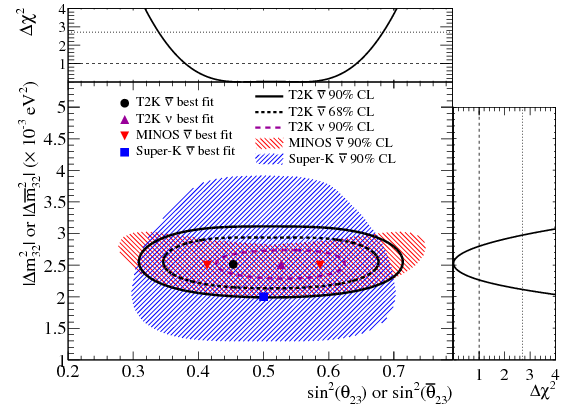
T2K reports its first measurements of the parameters governing the disappearance of ν̅μ in an off-axis beam due to flavor change induced by neutrino oscillations. The quasimonochromatic ν̅μ beam, produced with a peak energy of 0.6 GeV at J-PARC, is observed at the far detector Super-Kamiokande, 295 km away, where the ν̅μ survival probability is expected to be minimal. Using a data set corresponding to 4.01×1020 protons on target, 34 fully contained μ-like events were observed. The best-fit oscillation parameters are sin2(θ̅23)=0.45 and |Δm̅232|=2.51×10−3 eV2 with 68% confidence intervals of 0.38–0.64 and 2.26–2.80×10−3 eV2, respectively. These results are in agreement with existing antineutrino parameter measurements and also with the νμ disappearance parameters measured by T2K.
Measurement of double-differential muon neutrino charged-current interactions on C8H8 without pions in the final state using the T2K off-axis beam
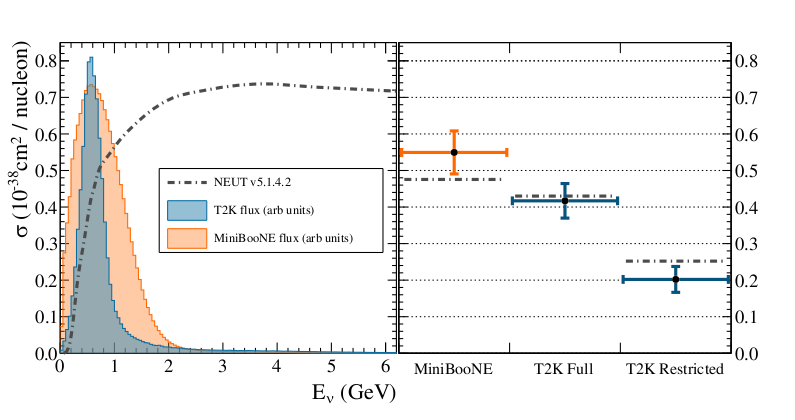
We report the measurement of muon neutrino charged-current interactions on carbon without pions in the final state at the T2K beam energy using 5.734×1020 protons on target. For the first time the measurement is reported as a flux-integrated, double-differential cross-section in muon kinematic variables (cosθμ, pμ), without correcting for events where a pion is produced and then absorbed by final state interactions. Two analyses are performed with different selections, background evaluations and cross-section extraction methods to demonstrate the robustness of the results against biases due to model-dependent assumptions. The measurements compare favorably with recent models which include nucleon-nucleon correlations but, given the present precision, the measurement does not solve the degeneracy between different models. The data also agree with Monte Carlo simulations which use effective parameters that are tuned to external data to describe the nuclear effects. The total cross-section in the full phase space is σ=(0.417±0.047(syst)±0.005(stat))×10−38cm2 nucleon−1 and the cross-section integrated in the region of phase space with largest efficiency and best signal-over-background ratio (cosθμ>0.6 and pμ>200 MeV) is σ=(0.202±0.0359(syst)±0.0026(stat))×10−38cm2 nucleon−1.
Upper bound on neutrino mass based on T2K neutrino timing measurements
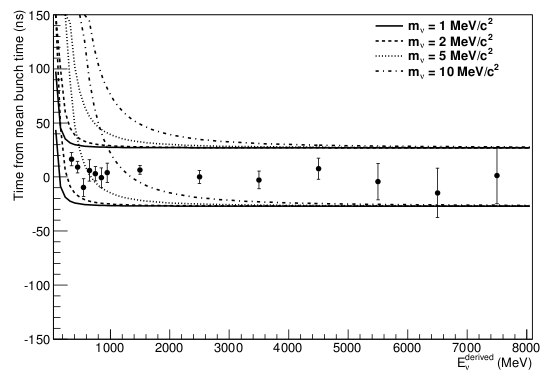
The present work utilizes the T2K event timing measurements at the near and far detectors to study neutrino time of flight as a function of derived neutrino energy. Under the assumption of a relativistic relation between energy and time of flight, constraints on the neutrino rest mass can be derived. The sub-GeV neutrino beam in conjunction with timing precision of order tens of ns provide sensitivity to neutrino mass in the few MeV/c2 range. We study the distribution of relative arrival times of muon and electron neutrino candidate events at the T2K far detector as a function of neutrino energy. The 90% C.L. upper limit on the mixture of neutrino mass eigenstates represented in the data sample is found to be mν2<5.6 MeV2/c4.
Measurement of the muon neutrino inclusive charged-current cross section in the energy range of 1-3 GeV with the T2K INGRID detector
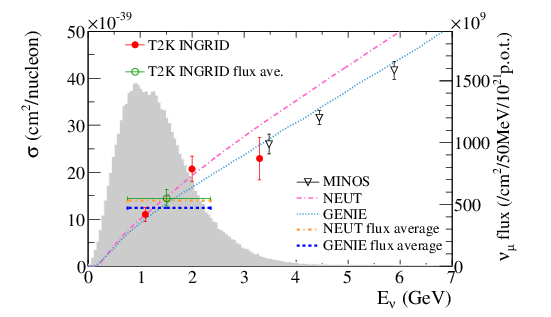
We report a measurement of the νμ-nucleus inclusive charged current cross section (=σcc) on iron using data from exposed to the J-PARC neutrino beam. The detector consists of 14 modules in total, which are spread over a range of off-axis angles from 0° to 1.1°. The variation in the neutrino energy spectrum as a function of the off-axis angle, combined with event topology information, is used to calculate this cross section as a function of neutrino energy. The cross section is measured to be σcc(1.1 GeV)=1.10±0.15 (10−38cm2/nucleon), σcc(2.0 GeV)=2.07±0.27 (10−38cm2/nucleon), and σcc(3.3 GeV)=2.29±0.45 (10−38cm2/nucleon), at energies of 1.1, 2.0, and 3.3 GeV, respectively. These results are consistent with the cross section calculated by the neutrino interaction generators currently used by T2K. More importantly, the method described here opens up a new way to determine the energy dependence of neutrino-nucleus cross sections.
Measurement of the Electron Neutrino Charged-current Interaction Rate on Water with the T2K ND280 pi-zero Detector
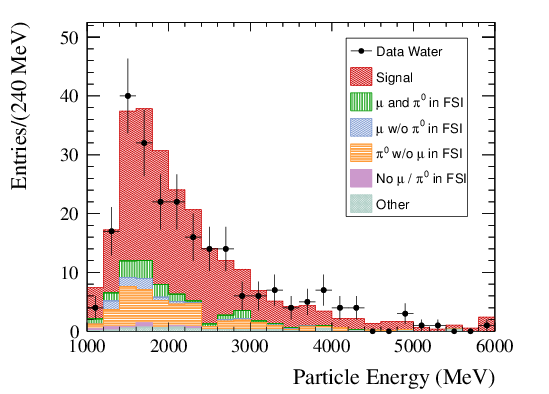
The first direct observation of the appearance of electron neutrinos in a muon neutrino beam through neutrino oscillation was recently reported by the T2K experiment. The main background in this observation was the presence of the electron neutrino component of the beam, which accounts for 1.2% of the beam below the 1.2 GeV threshold. This paper presents a measurement of the charged current interaction rate of the electron neutrino beam component using the large fiducial mass of the T2K π0 detector. The measured ratio of the observed beam interaction rate to the predicted rate in the detector with water targets filled is 0.89 ±0.08 (stat.) ±0.11 (sys.), and with the water targets emptied is 0.90 ±0.09 (stat.) ±0.13 (sys.). The ratio obtained for the interactions only on-water only an event subtraction method is 0.87 ±0.33 (stat.) ±0.21 (sys.). These are pioneering measurements of the νe interaction rate, particularly on water, which will become crucial in future CP-violation searches in the lepton sector.
Measurement of the νμ charged current quasi-elastic cross-section on carbon with the T2K on-axis neutrino beam
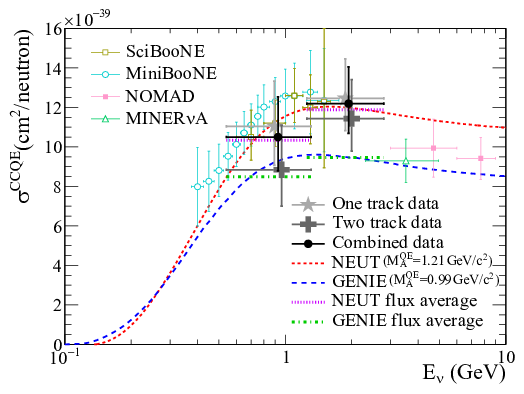
We report a measurement of the νμ charged current quasi-elastic cross-sections on carbon in the T2K on-axis neutrino beam. The measured charged current quasi-elastic cross-sections on carbon at mean neutrino energies of 1.94 GeV and 0.93 GeV are (11.95±0.19(stat.)+1.82−1.47(syst.))×10−39cm2/neutron and (10.64±0.37(stat.)+2.03−1.65(syst.))×10−39cm2/neutron, respectively. These results agree well with the predictions of neutrino interaction models. In addition, we investigated the effects of the nuclear model and the multi-nucleon interaction.
Measurements of neutrino oscillation in appearance and disappearance channels by the T2K experiment with 6.6E20 protons on target
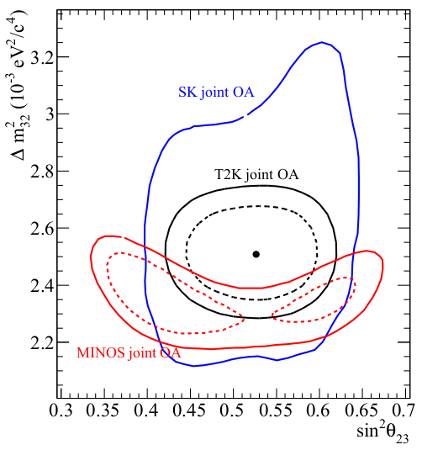
We report on measurements of neutrino oscillation using data from the T2K long-baseline neutrino experiment collected between 2010 and 2013. In an analysis of muon neutrino disappearance alone, we find the following estimates and 68% confidence intervals for the two possible mass hierarchies:
Normal Hierarchy: sin2θ23=0.514+0.055−0.056 and Δm232=(2.51±0.10)×10−3 eV2/c4
Inverted Hierarchy: sin2θ23=0.511±0.055 and Δm232=(2.48±0.10)×10−3 eV2/c4
The analysis accounts for multi-nucleon mechanisms in neutrino interactions which were found to introduce negligible bias.
We describe our first analyses that combine measurements of muon neutrino disappearance and electron neutrino appearance to estimate four oscillation parameters and the mass hierarchy. Frequentist and Bayesian intervals are presented for combinations of these parameters, with and without including recent reactor measurements. At 90% confidence level and including reactor measurements, we exclude the region:
δCP=[0.15,0.83]π for normal hierarchy and δCP=[−0.08,1.09]π for inverted hierarchy.
The T2K and reactor data weakly favor the normal hierarchy with a Bayes Factor of 2.2. The most probable values and 68% 1D credible intervals for the other oscillation parameters, when reactor data are included, are:
sin2θ23=0.528+0.055−0.038 and |Δm232|=(2.51±0.11)×10−3 eV2/c4.
Measurement of the νμ CCQE cross section on carbon with the ND280 detector at T2K
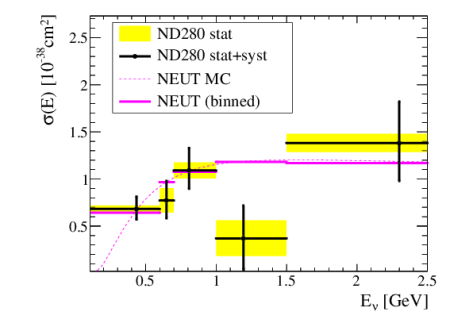
The Charged-Current Quasi-Elastic (CCQE) interaction, νl+n→l−+p, is the dominant CC process at Eν∼1 GeV and contributes to the signal in accelerator-based long-baseline neutrino oscillation experiments operating at intermediate neutrino energies. This paper reports a measurement by the T2K experiment of the νμ CCQE cross section on a carbon target with the off-axis detector based on the observed distribution of muon momentum (pμ) and angle with respect to the incident neutrino beam (θμ). The flux-integrated CCQE cross section was measured to be (0.83±0.12)×10−38 cm2 in good agreement with NEUT MC value of 0.88×10−38 cm2. The energy dependence of the CCQE cross section is also reported. The axial mass, MAQE, of the dipole axial form factor was extracted assuming the Smith-Moniz CCQE model with a relativistic Fermi gas nuclear model. Using the absolute (shape-only) pμcosθμ distribution, the effective MAQE parameter was measured to be 1.26+0.21−0.18 GeV/c2 (1.43+0.28−0.22 GeV/c2).
Search for short baseline νe disappearance with the T2K near detector
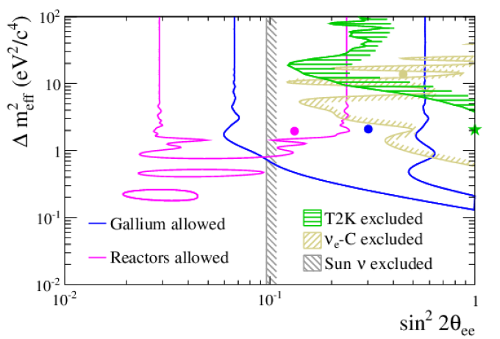
The T2K experiment has performed a search for νe disappearance due to sterile neutrinos using 5.9×1020 protons on target for a baseline of 280m in a neutrino beam peaked at about 500MeV. A sample of νe CC interactions in the off-axis near detector has been selected with a purity of 63% and an efficiency of 26%. The p-value for the null hypothesis is 0.085 and the excluded region at 95% CL is approximately sin22θee > 0.3 for Δm2eff > 7eV2/c4.
Neutrino Oscillation Physics Potential of the T2K Experiment
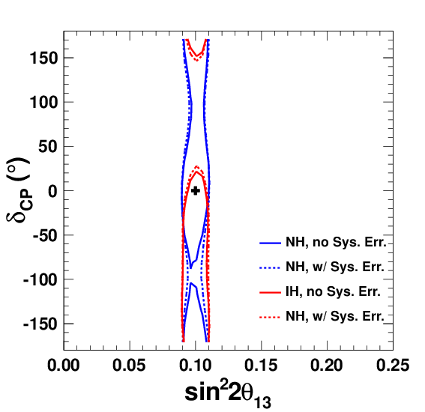
The observation of the recent electron neutrino appearance in a muon neutrino beam and the high-precision measurement of the mixing angle θ13 have led to a re-evaluation of the physics potential of the T2K long-baseline neutrino oscillation experiment. Sensitivities are explored for CP violation in neutrinos, non-maximal sin22θ23, the octant of θ23, and the mass hierarchy, in addition to the measurements of δCP, sin2θ23, and Δm232, for various combinations of neutrino-mode and anti-neutrino-mode data-taking.
With an exposure of 7.8×1021~protons-on-target, T2K can achieve 1-σ resolution of 0.050(0.054) on sin2θ23 and 0.040(0.045)×10−3 eV2 on Δm232 for 100%(50%) neutrino beam mode running assuming sin2θ23=0.5 and Δm232=2.4×10−3 eV2. T2K will have sensitivity to the CP-violating phase δCP at 90% C.L. or better over a significant range. For example, if sin22θ23 is maximal (i.e θ23=45°) the range is −115°<δCP<−60° for normal hierarchy and +50°<δCP<+130° for inverted hierarchy. When T2K data is combined with data from the NOνA experiment, the region of oscillation parameter space where there is sensitivity to observe a non-zero δCP is substantially increased compared to if each experiment is analyzed alone.



